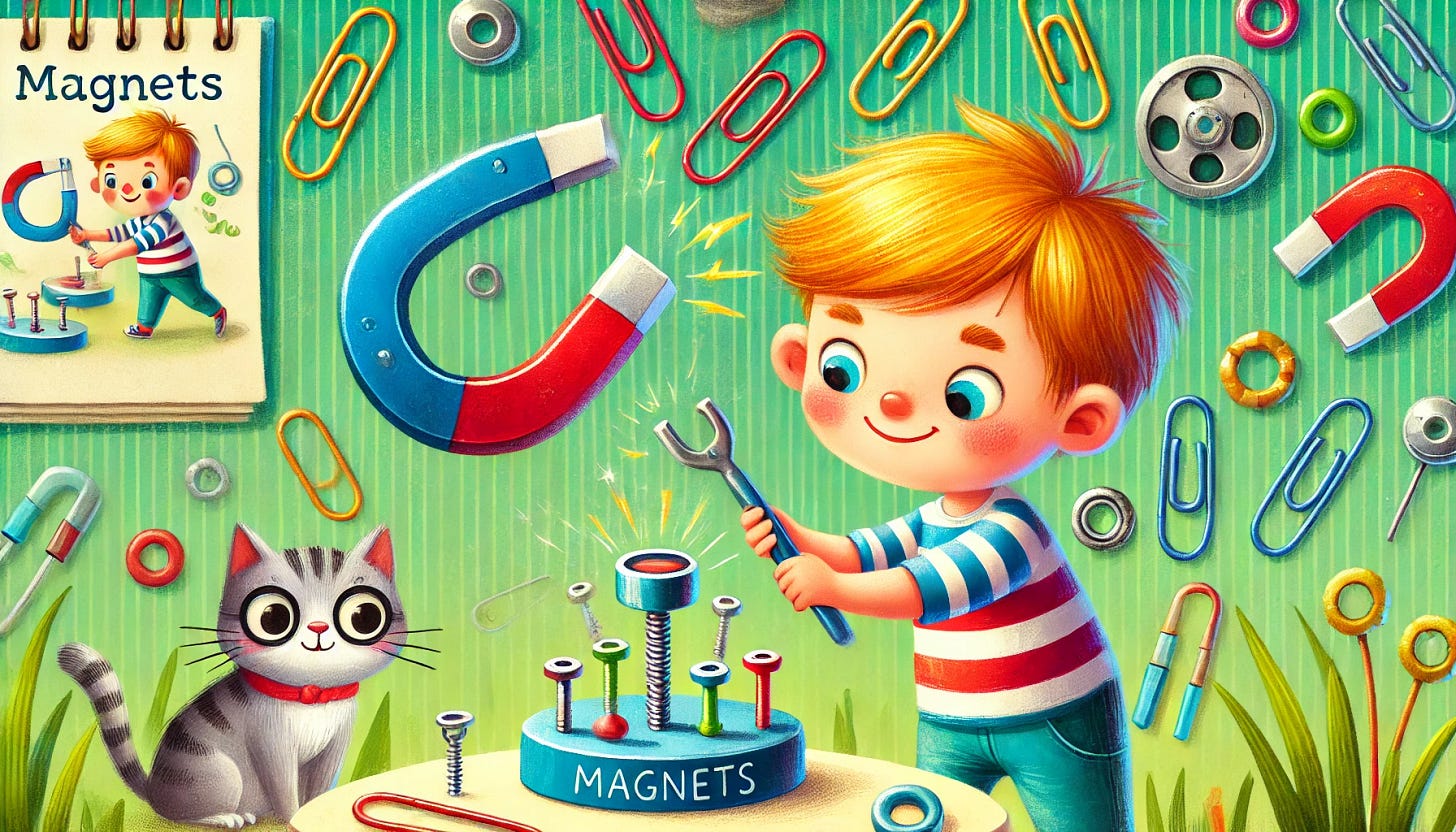Introduction
Have you ever played with a magnet and noticed how it sticks to some things but not others? Maybe you’ve seen magnets on your refrigerator holding up pictures and notes. But why do magnets stick to metal and not to things like paper or plastic? Let’s explore the magical world of magnets and find out!
Hello my friends!
For a quick note, welcome to Tidbits with Titus, a podcast and newsletter where we tackle the big, curious questions kids ask every day in fun, bite-sized ways! I’m Alexander Titus, but I go by Titus. I’m a scientist, adventurer, and a huge fan of making science, technology, and life accessible to all ages. From “How does electricity work?” to “What are taxes?” and even “Why is the sky blue?” I’m here to dive into these wonder-filled questions with engaging stories and simple explanations that spark curiosity and make learning a joy. This effort is all about creating a space where families can learn together, discover the magic of the every day, and find thoughtful ways to explore the world’s big mysteries. Let’s make curiosity a family tradition—one tidbit at a time!
Just so you know, these podcast episodes are all AI-generated using Google’s really cool NotebookLM technology. That means there are some errors in how words are said, but that is part of the fun!
If your little ones have questions that you want help answering, shoot me an email at questions@tidbitswithtitus.com and I’ll see what I can do!
You can subscribe to the newsletter that has this information as well at tidbitswithtitus.com.
Also please share with anyone you think would be interested. The more the merrier!
Cheers,
-Titus
What is a Magnet?
A magnet is a special object that can pull certain metals toward it. This pulling force is called magnetism. Magnets come in many shapes and sizes, from small fridge magnets to huge magnets used in science labs and machines!
What Metals Do Magnets Stick To?
Magnets don’t stick to just any metal—they are attracted to special metals like iron, nickel, and cobalt. These metals have tiny invisible forces inside them that make them react to magnets.
Some common objects that magnets stick to include:
Refrigerators (because they have iron inside!)
Paperclips
Screws and nails
Some coins (like old ones that contain nickel!)
Metal tools
Why Do Magnets Stick to Metal?
Inside metals like iron, nickel, and cobalt, there are tiny invisible things called atoms. Atoms have even smaller parts inside them, one of which is called an electron. These electrons move around and create tiny electric currents. In some metals, like iron, the electrons move in a way that makes the metal act like a magnet itself!
Magnets have two ends, called poles:
North Pole (N)
South Pole (S)
When a magnet gets close to a metal like iron, it makes the tiny parts inside the metal line up in the same direction. This makes the metal act like a magnet for a short time, and the two objects pull toward each other. That’s why your fridge magnet sticks to the refrigerator!
What Happens If You Put Two Magnets Together?
Magnets can pull together or push apart depending on how they are placed.
If you put the North Pole of one magnet near the South Pole of another, they will pull together. This is called attraction.
If you put two North Poles or two South Poles together, they will push away from each other. This is called repulsion.
Try this with two magnets at home—can you feel them push away when you put the same poles together?
Fun Magnet Experiments!
Want to see how magnets work? Try these fun experiments:
1️⃣ Magnet Hunt: Walk around your house with a magnet and test which objects it sticks to. Can you find things made of iron or nickel?
2️⃣ Magnetic Fishing: Put paperclips in a bowl and use a magnet to “catch” them!
3️⃣ Magnet Train: Line up some small magnets and see how they pull or push each other along a table.
Do Magnets Work in Water and Space?
Yes! Magnets can still stick to metal underwater. That’s why some treasure hunters use big magnets to find lost metal objects in rivers and lakes.
Magnets also work in space! Scientists use magnets to help spacecrafts and satellites stay in the right place.
Can Magnets Lose Their Strength?
Yes, but it takes a long time! If a magnet gets too hot, is dropped too many times, or is placed near another strong magnet, it can start to lose its power. However, most magnets last a very long time!
How Do We Use Magnets Every Day?
Magnets are not just for fun—they help us in many ways!
Refrigerator magnets hold up pictures and notes.
Compasses use a magnet to point north and help people find directions.
Computers and phones have tiny magnets inside to store information.
Doctors use a giant magnet in MRI machines to take pictures of the inside of our bodies.
Conclusion
Magnets are amazing! They stick to metals like iron because of tiny invisible forces inside the metal. They can pull together or push apart, work underwater, and are used in many important ways. The next time you play with a magnet, remember—you’re holding something truly magical!














Share this post